Research and Evaluation of Key Issues in Strategic and Operational Management
VerifiedAdded on 2023/04/06
|7
|946
|314
Presentation
AI Summary
This presentation focuses on the research and evaluation of key issues in strategic and operational management. It discusses the implementation of Holacracy and its impact on organizational culture and employee performance. It also explores the criticism of theoretical models and their application to case study examples. Additionally, it examines the relationship between strategic management practice and managing operations in organizations.
Contribute Materials
Your contribution can guide someone’s learning journey. Share your
documents today.

STRATEGIC
OPERATIONAL
MANAGEMENT
CRITICAL ANALYSIS
OPERATIONAL
MANAGEMENT
CRITICAL ANALYSIS
Secure Best Marks with AI Grader
Need help grading? Try our AI Grader for instant feedback on your assignments.
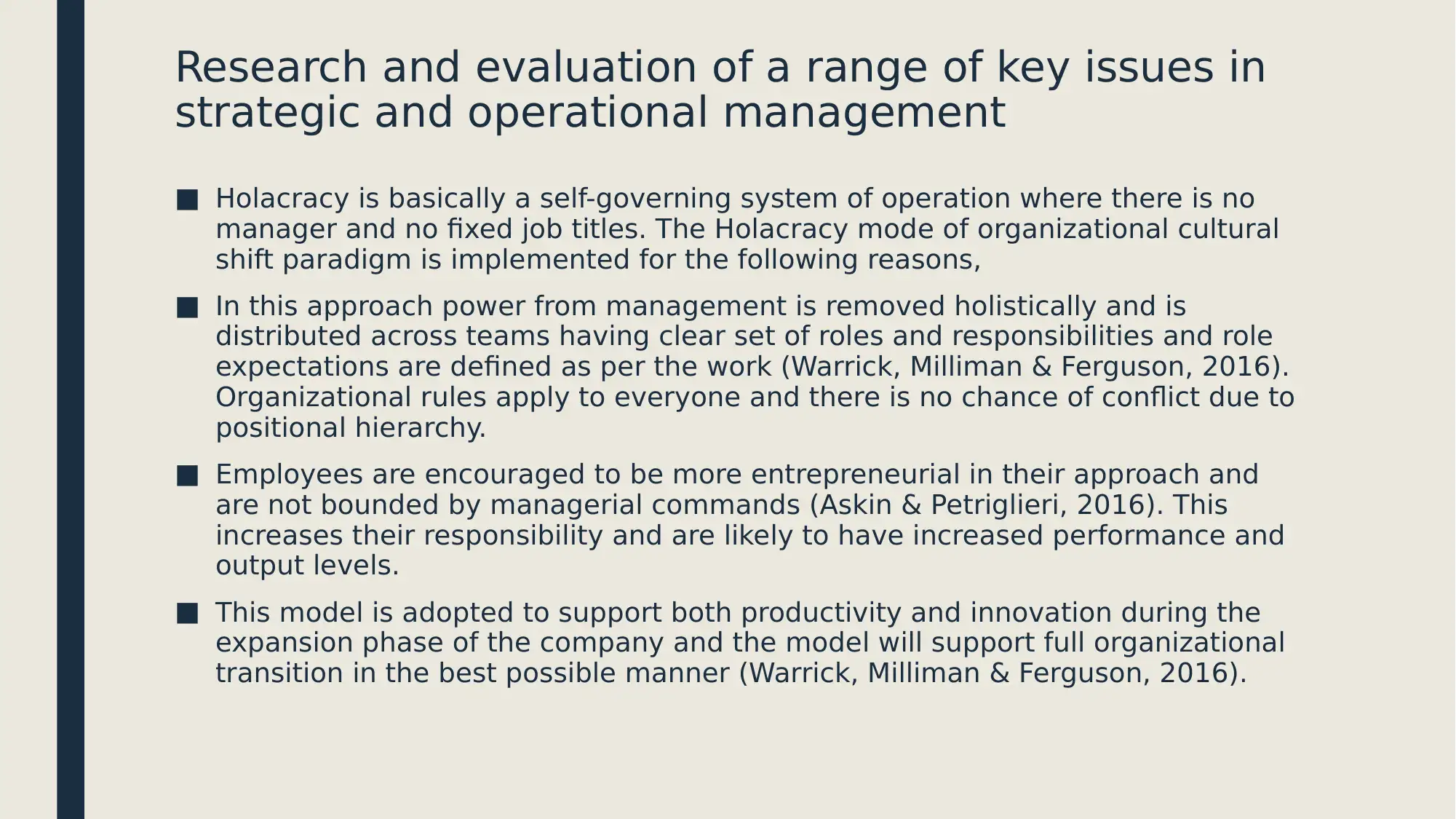
Research and evaluation of a range of key issues in
strategic and operational management
■ Holacracy is basically a self-governing system of operation where there is no
manager and no fixed job titles. The Holacracy mode of organizational cultural
shift paradigm is implemented for the following reasons,
■ In this approach power from management is removed holistically and is
distributed across teams having clear set of roles and responsibilities and role
expectations are defined as per the work (Warrick, Milliman & Ferguson, 2016).
Organizational rules apply to everyone and there is no chance of conflict due to
positional hierarchy.
■ Employees are encouraged to be more entrepreneurial in their approach and
are not bounded by managerial commands (Askin & Petriglieri, 2016). This
increases their responsibility and are likely to have increased performance and
output levels.
■ This model is adopted to support both productivity and innovation during the
expansion phase of the company and the model will support full organizational
transition in the best possible manner (Warrick, Milliman & Ferguson, 2016).
strategic and operational management
■ Holacracy is basically a self-governing system of operation where there is no
manager and no fixed job titles. The Holacracy mode of organizational cultural
shift paradigm is implemented for the following reasons,
■ In this approach power from management is removed holistically and is
distributed across teams having clear set of roles and responsibilities and role
expectations are defined as per the work (Warrick, Milliman & Ferguson, 2016).
Organizational rules apply to everyone and there is no chance of conflict due to
positional hierarchy.
■ Employees are encouraged to be more entrepreneurial in their approach and
are not bounded by managerial commands (Askin & Petriglieri, 2016). This
increases their responsibility and are likely to have increased performance and
output levels.
■ This model is adopted to support both productivity and innovation during the
expansion phase of the company and the model will support full organizational
transition in the best possible manner (Warrick, Milliman & Ferguson, 2016).
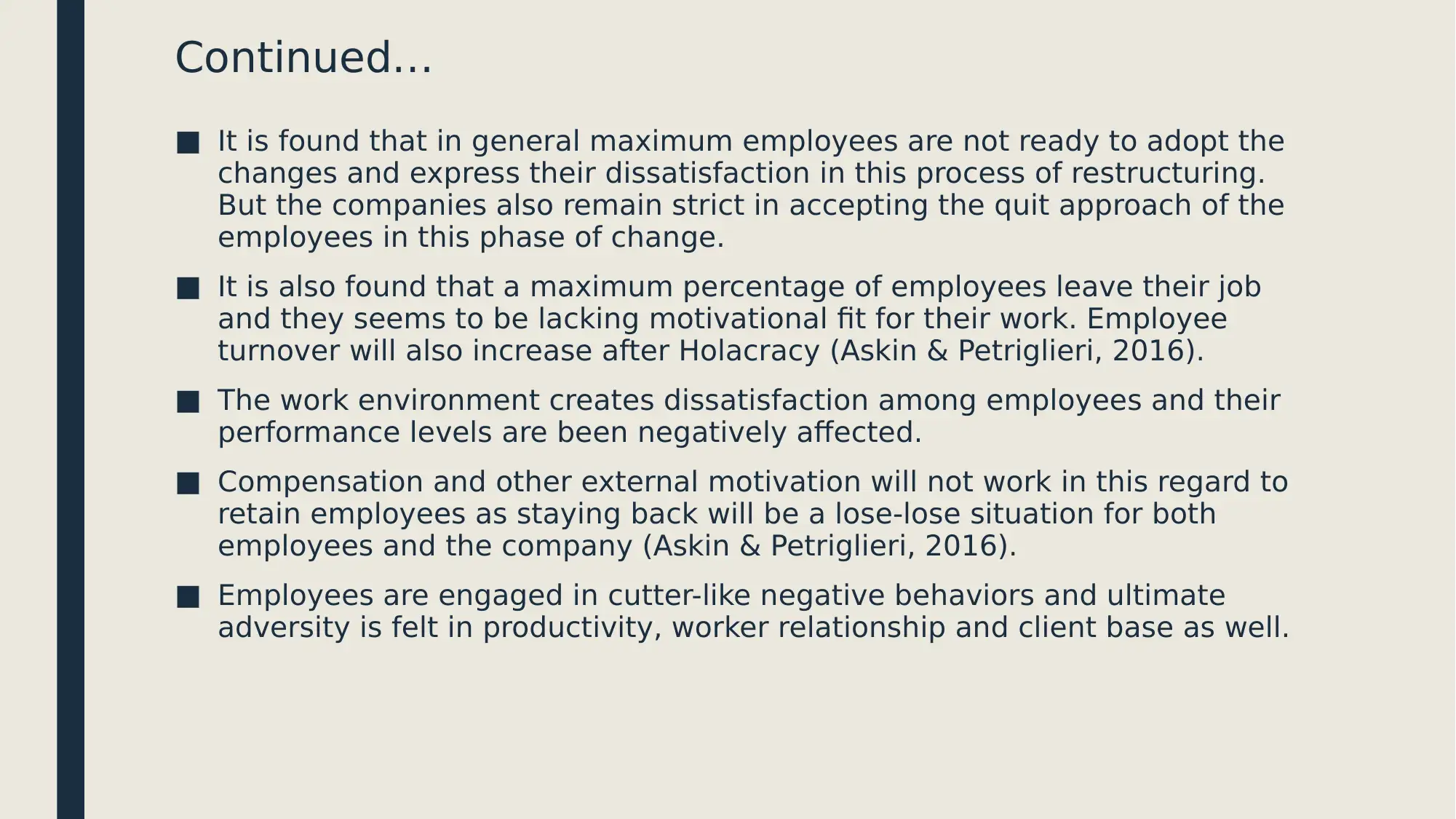
Continued…
■ It is found that in general maximum employees are not ready to adopt the
changes and express their dissatisfaction in this process of restructuring.
But the companies also remain strict in accepting the quit approach of the
employees in this phase of change.
■ It is also found that a maximum percentage of employees leave their job
and they seems to be lacking motivational fit for their work. Employee
turnover will also increase after Holacracy (Askin & Petriglieri, 2016).
■ The work environment creates dissatisfaction among employees and their
performance levels are been negatively affected.
■ Compensation and other external motivation will not work in this regard to
retain employees as staying back will be a lose-lose situation for both
employees and the company (Askin & Petriglieri, 2016).
■ Employees are engaged in cutter-like negative behaviors and ultimate
adversity is felt in productivity, worker relationship and client base as well.
■ It is found that in general maximum employees are not ready to adopt the
changes and express their dissatisfaction in this process of restructuring.
But the companies also remain strict in accepting the quit approach of the
employees in this phase of change.
■ It is also found that a maximum percentage of employees leave their job
and they seems to be lacking motivational fit for their work. Employee
turnover will also increase after Holacracy (Askin & Petriglieri, 2016).
■ The work environment creates dissatisfaction among employees and their
performance levels are been negatively affected.
■ Compensation and other external motivation will not work in this regard to
retain employees as staying back will be a lose-lose situation for both
employees and the company (Askin & Petriglieri, 2016).
■ Employees are engaged in cutter-like negative behaviors and ultimate
adversity is felt in productivity, worker relationship and client base as well.
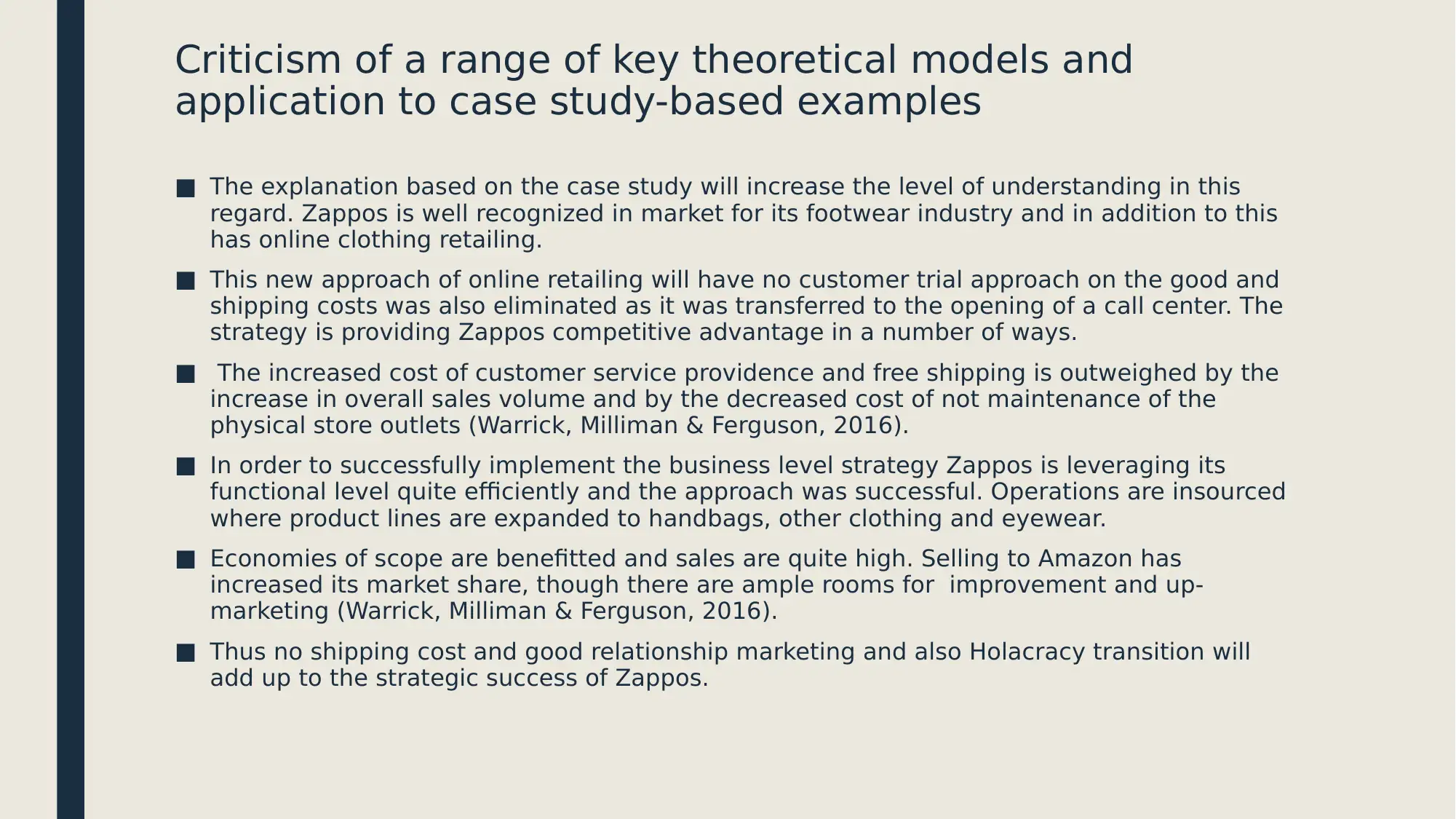
Criticism of a range of key theoretical models and
application to case study-based examples
■ The explanation based on the case study will increase the level of understanding in this
regard. Zappos is well recognized in market for its footwear industry and in addition to this
has online clothing retailing.
■ This new approach of online retailing will have no customer trial approach on the good and
shipping costs was also eliminated as it was transferred to the opening of a call center. The
strategy is providing Zappos competitive advantage in a number of ways.
■ The increased cost of customer service providence and free shipping is outweighed by the
increase in overall sales volume and by the decreased cost of not maintenance of the
physical store outlets (Warrick, Milliman & Ferguson, 2016).
■ In order to successfully implement the business level strategy Zappos is leveraging its
functional level quite efficiently and the approach was successful. Operations are insourced
where product lines are expanded to handbags, other clothing and eyewear.
■ Economies of scope are benefitted and sales are quite high. Selling to Amazon has
increased its market share, though there are ample rooms for improvement and up-
marketing (Warrick, Milliman & Ferguson, 2016).
■ Thus no shipping cost and good relationship marketing and also Holacracy transition will
add up to the strategic success of Zappos.
application to case study-based examples
■ The explanation based on the case study will increase the level of understanding in this
regard. Zappos is well recognized in market for its footwear industry and in addition to this
has online clothing retailing.
■ This new approach of online retailing will have no customer trial approach on the good and
shipping costs was also eliminated as it was transferred to the opening of a call center. The
strategy is providing Zappos competitive advantage in a number of ways.
■ The increased cost of customer service providence and free shipping is outweighed by the
increase in overall sales volume and by the decreased cost of not maintenance of the
physical store outlets (Warrick, Milliman & Ferguson, 2016).
■ In order to successfully implement the business level strategy Zappos is leveraging its
functional level quite efficiently and the approach was successful. Operations are insourced
where product lines are expanded to handbags, other clothing and eyewear.
■ Economies of scope are benefitted and sales are quite high. Selling to Amazon has
increased its market share, though there are ample rooms for improvement and up-
marketing (Warrick, Milliman & Ferguson, 2016).
■ Thus no shipping cost and good relationship marketing and also Holacracy transition will
add up to the strategic success of Zappos.
Secure Best Marks with AI Grader
Need help grading? Try our AI Grader for instant feedback on your assignments.
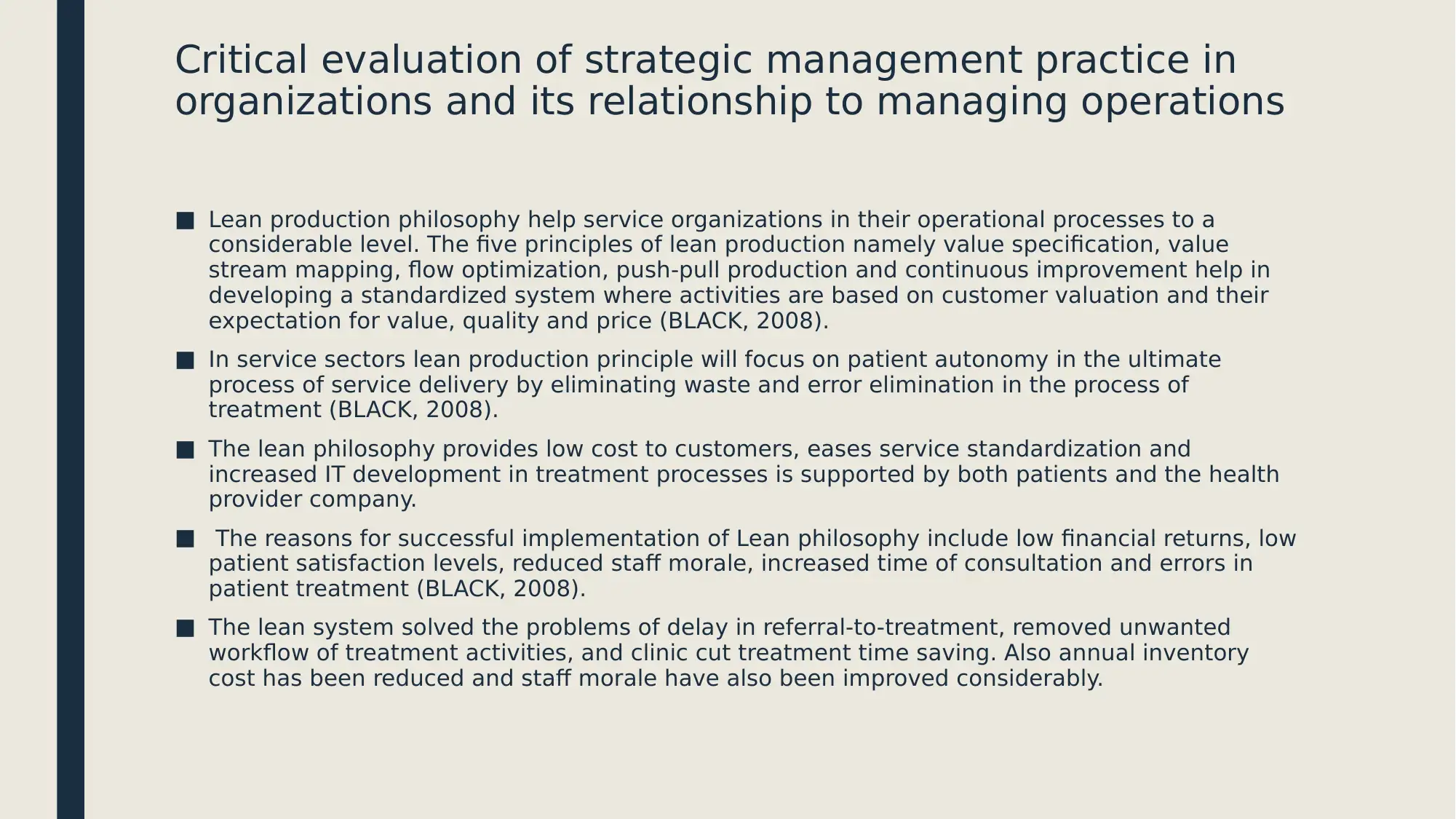
Critical evaluation of strategic management practice in
organizations and its relationship to managing operations
■ Lean production philosophy help service organizations in their operational processes to a
considerable level. The five principles of lean production namely value specification, value
stream mapping, flow optimization, push-pull production and continuous improvement help in
developing a standardized system where activities are based on customer valuation and their
expectation for value, quality and price (BLACK, 2008).
■ In service sectors lean production principle will focus on patient autonomy in the ultimate
process of service delivery by eliminating waste and error elimination in the process of
treatment (BLACK, 2008).
■ The lean philosophy provides low cost to customers, eases service standardization and
increased IT development in treatment processes is supported by both patients and the health
provider company.
■ The reasons for successful implementation of Lean philosophy include low financial returns, low
patient satisfaction levels, reduced staff morale, increased time of consultation and errors in
patient treatment (BLACK, 2008).
■ The lean system solved the problems of delay in referral-to-treatment, removed unwanted
workflow of treatment activities, and clinic cut treatment time saving. Also annual inventory
cost has been reduced and staff morale have also been improved considerably.
organizations and its relationship to managing operations
■ Lean production philosophy help service organizations in their operational processes to a
considerable level. The five principles of lean production namely value specification, value
stream mapping, flow optimization, push-pull production and continuous improvement help in
developing a standardized system where activities are based on customer valuation and their
expectation for value, quality and price (BLACK, 2008).
■ In service sectors lean production principle will focus on patient autonomy in the ultimate
process of service delivery by eliminating waste and error elimination in the process of
treatment (BLACK, 2008).
■ The lean philosophy provides low cost to customers, eases service standardization and
increased IT development in treatment processes is supported by both patients and the health
provider company.
■ The reasons for successful implementation of Lean philosophy include low financial returns, low
patient satisfaction levels, reduced staff morale, increased time of consultation and errors in
patient treatment (BLACK, 2008).
■ The lean system solved the problems of delay in referral-to-treatment, removed unwanted
workflow of treatment activities, and clinic cut treatment time saving. Also annual inventory
cost has been reduced and staff morale have also been improved considerably.
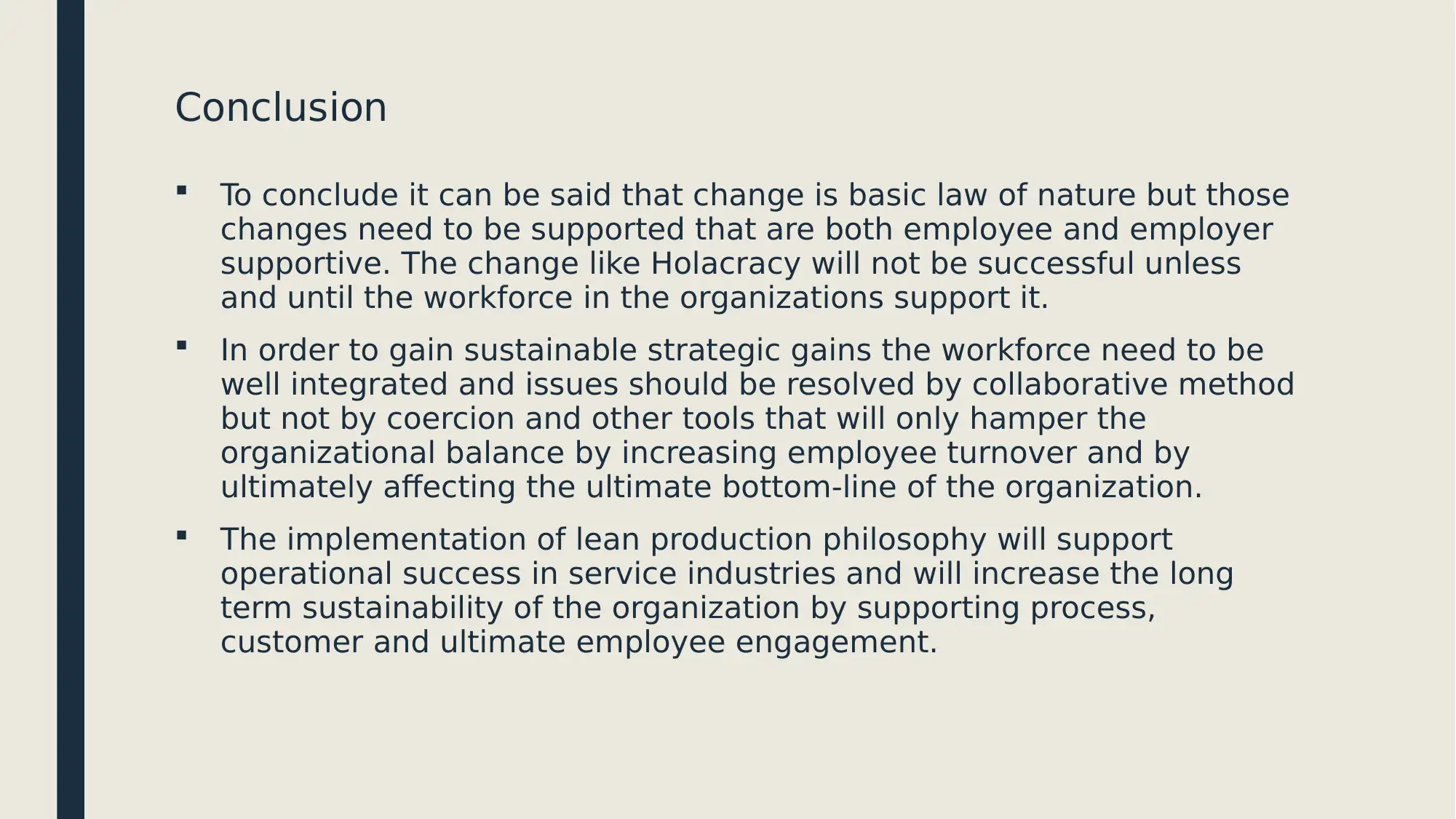
Conclusion
To conclude it can be said that change is basic law of nature but those
changes need to be supported that are both employee and employer
supportive. The change like Holacracy will not be successful unless
and until the workforce in the organizations support it.
In order to gain sustainable strategic gains the workforce need to be
well integrated and issues should be resolved by collaborative method
but not by coercion and other tools that will only hamper the
organizational balance by increasing employee turnover and by
ultimately affecting the ultimate bottom-line of the organization.
The implementation of lean production philosophy will support
operational success in service industries and will increase the long
term sustainability of the organization by supporting process,
customer and ultimate employee engagement.
To conclude it can be said that change is basic law of nature but those
changes need to be supported that are both employee and employer
supportive. The change like Holacracy will not be successful unless
and until the workforce in the organizations support it.
In order to gain sustainable strategic gains the workforce need to be
well integrated and issues should be resolved by collaborative method
but not by coercion and other tools that will only hamper the
organizational balance by increasing employee turnover and by
ultimately affecting the ultimate bottom-line of the organization.
The implementation of lean production philosophy will support
operational success in service industries and will increase the long
term sustainability of the organization by supporting process,
customer and ultimate employee engagement.
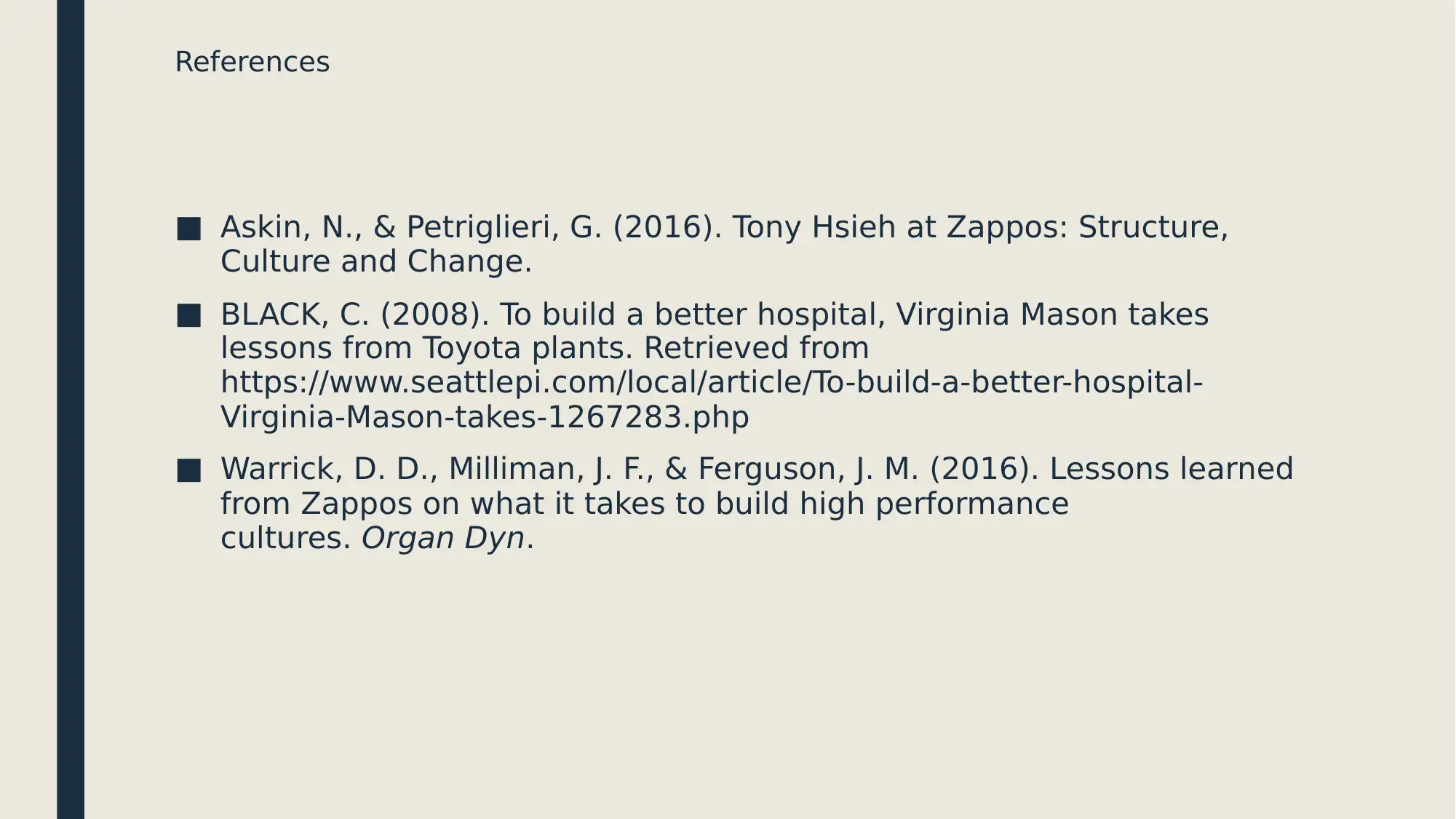
References
■ Askin, N., & Petriglieri, G. (2016). Tony Hsieh at Zappos: Structure,
Culture and Change.
■ BLACK, C. (2008). To build a better hospital, Virginia Mason takes
lessons from Toyota plants. Retrieved from
https://www.seattlepi.com/local/article/To-build-a-better-hospital-
Virginia-Mason-takes-1267283.php
■ Warrick, D. D., Milliman, J. F., & Ferguson, J. M. (2016). Lessons learned
from Zappos on what it takes to build high performance
cultures. Organ Dyn.
■ Askin, N., & Petriglieri, G. (2016). Tony Hsieh at Zappos: Structure,
Culture and Change.
■ BLACK, C. (2008). To build a better hospital, Virginia Mason takes
lessons from Toyota plants. Retrieved from
https://www.seattlepi.com/local/article/To-build-a-better-hospital-
Virginia-Mason-takes-1267283.php
■ Warrick, D. D., Milliman, J. F., & Ferguson, J. M. (2016). Lessons learned
from Zappos on what it takes to build high performance
cultures. Organ Dyn.
1 out of 7
Related Documents
Your All-in-One AI-Powered Toolkit for Academic Success.
+13062052269
info@desklib.com
Available 24*7 on WhatsApp / Email
![[object Object]](/_next/static/media/star-bottom.7253800d.svg)
Unlock your academic potential
© 2024 | Zucol Services PVT LTD | All rights reserved.



